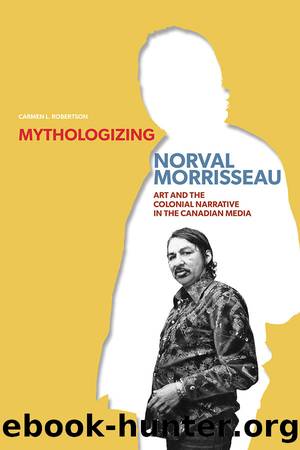Mythologizing Norval Morrisseau by Carmen L. Robertson

Author:Carmen L. Robertson
Language: eng
Format: epub
Publisher: University of Manitoba Press
Published: 2016-04-06T16:00:00+00:00
CHAPTER FOUR
1980s: An Unruly International Art Star
[Morrisseau] lived life in epic proportions ... great drunks, long absences from work, dramatic trances and probably recurring fits of suspicion of the giant he had unleashed and the giant powers of the art market ... he had become a star of the fickle, fast-moving popular art market which set life at a pace and made demands that he could not temperamentally cope with.1
Grace Inglis, Hamilton Spectator, 1982
The 1980s was a time when Morrisseau was continually linked to the terms magic, magician, and shaman. Beginning in 1981 with a headline that stated that Morrisseau was exploring âMagic Forests of the Mind,â reporters began to use the term âmagicâ in both laudatory (as in this case) and derisive ways. After a series of negative stories in May 1987, a Globe and Mail piece began with a quote by Morrisseau, who also uses âmagicalâ to describe his art: â âNow Is the Magical Moment. I Start Again.â No Regrets, No Booze for Norval Morrisseau.â2 Whether noting that Morrisseauâs magic was drained or labelling Morrisseau a magician, art critics, reporters, and curators used the term to either reinforce his shamanic powers or belittle him as little more than a flim-flam artistâall smoke and mirrors. At the end of the decade he appeared in an important international art exhibition in Paris, France, to celebrate the two-hundredth anniversary of the French Revolution. The exhibition, titled Magiciens de la Terre, framed him and other artists from around the globe as magicians. Firmly established as a shaman artist, Morrisseauâs mythical identity gels as a magician, though this part of his myth did not endure beyond the 1990s.
The main events that cropped up in papers during this decade highlight the ongoing bifurcation of the artist and the Imaginary Indian, except that in the 1980s the highs reached much higher and the lows found depths much lower than had otherwise been publicly reported. Morrisseau was both feted and dismissed in competing narratives. One example of dismissal of Morrisseauâs significance occurred in an art review in 1980. Art Perry, writing in the Vancouver Province about an exhibition of Morrisseauâs art at the Vancouver Art Gallery, lamented that the art had not remained authentically aligned with pre-contact Woodland traditions, which he characterized as a âonce sincere art form.â3 The provocative headline, âItâs Sham Rather than Shamanism,â inspired the title of Blundell and Phillipsâs 1983 essay on media analysis and Morrisseauâs art.4 Perry finds fault with Morrisseauâs art and image as a shaman because the artist refused to maintain a frozen-in-time image the reviewer valued.5
As in the 1970s, Morrisseau was compared to other Indigenous artists and for the most part, he lost out to educated artists like Janvier and Houle. Carl Beam now took the place of Alex Janvier as an artistic comparison for Morrisseau in the press, perhaps because he was also Anishinaabe and from northwestern Ontario. Beamâs art practice was radically different from Morrisseauâs and prompted stark judgements. Described in a 1981 news story
Download
This site does not store any files on its server. We only index and link to content provided by other sites. Please contact the content providers to delete copyright contents if any and email us, we'll remove relevant links or contents immediately.
Technical Art History by Jehane Ragai(451)
Art, Science, and the Natural World in the Ancient Mediterranean, 300 BC to AD 100 by JOSHUA J. THOMAS(405)
Graphic Culture by Lerner Jillian;(396)
The Slavic Myths by Noah Charney(366)
Pollak's Arm by Hans von Trotha(337)
Treasuring the Gaze by Hanneke Grootenboer(336)
Simply Artificial Intelligence by Dorling Kindersley(335)
Sketchbook Confidential: Secrets from the private sketches of over 40 master artists by Editors of North Light Books(333)
The Art of Portrait Drawing by Cuong i(329)
Drawing for the Soul by Zoë Ingram(326)
Drawing Landscapes by Barrington Barber(317)
Mountain Manâs Field Guide to Grammar by Gary Spina(309)
The Art of Painting Sea Life in Watercolor by Maury Aaseng Hailey E. Herrera Louise De Masi and Ronald Pratt(308)
Portrait of a Woman by Bridget Quinn(295)
Anatomy for the Artist by Jennifer Crouch(289)
A text-book of the history of painting by Van Dyke John Charles 1856-1932(287)
Preparing Dinosaurs by Wylie Caitlin Donahue;(279)
Botanical Illustration by Valerie Price(277)
Egyptian art by Jean Capart(276)
